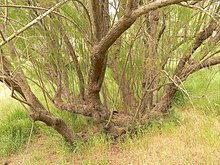Tamarix nilotica, the Nile tamarisk is a species of shrub or small tree in the tamarisk family. It is found in arid parts of North Africa and the Middle East, particularly areas with high salinity. It forms part of the dune stabilisation process.
| Tamarix nilotica | |
|---|---|

| |
| Scientific classification | |
| Kingdom: | Plantae |
| Clade: | Tracheophytes |
| Clade: | Angiosperms |
| Clade: | Eudicots |
| Order: | Caryophyllales |
| Family: | Tamaricaceae |
| Genus: | Tamarix |
| Species: | T. nilotica
|
| Binomial name | |
| Tamarix nilotica | |
Description
editTamarix nilotica is a much-branched shrub or small tree up to 10 m (33 ft) high. The twigs are slender and are half-clasped by the tiny, narrow, lanceolate leaves, up to 3 mm (0.1 in) long. The inflorescence is a raceme 5 to 10 cm (2 to 4 in) long, with many small white or pink flowers, each with a short pedicel, five sepals, five petals and five stamens.[2]
Distribution and habitat
editTamarix nilotica is found in Lebanon, Palestine, Egypt, Sudan, Somalia, Ethiopia and Kenya. In the Nile Valley in Egypt, this tree grows beside the river and the irrigation channels. It can form dense thickets in suitable locations.[1] It is also found as part of a salt-tolerant community in saline depressions in the Western Desert,[3] and on coastal dunes where its deep roots are able to extract saline water from the subsoil; it has salt-excreting glands to rid itself of the excess salts that would otherwise accumulate.[4]
Ecology
editAt the Moghra oasis, in the Qattara Depression, there is a brackish lake and a Phragmites swamp, and T. nilotica dominates a zone on the edge of the oasis where the vegetation ceases and the surrounding arid plains start. Here it grows in association with Alhagi maurorum, Nitraria retusa Zygophyllum album and Cressa cretica.[3]
Uses
editTamarix nilotica can help stabilise sand and may form nabkhas as part of the dune forming process. Wind blown sand comes to rest at the foot of the shrub and accumulates, gradually creating a hummock; the shrub's extensive root system continues to extract moisture from the underlying saline substrate and grows at a faster rate than the mound rises.[5]
In Egypt, T. nilotica has been used in traditional medicine as an antiseptic, an antipyretic, for alleviating headaches and reducing inflammation. It also has a reputation as an aphrodisiac.[1]
References
edit- ^ a b c Akhani, H. (2014). "Tamarix nilotica". IUCN Red List of Threatened Species. 2014: e.T19179434A46081355. doi:10.2305/IUCN.UK.2014-1.RLTS.T19179434A46081355.en. Retrieved 20 November 2021.
- ^ "Tamarix nilotica". Global Plants. JSTOR. Retrieved 2 February 2016.
- ^ a b Zahran, M.A.; Willis, A.J. (2013). The Vegetation of Egypt. Springer Science & Business Media. p. 216. ISBN 978-94-015-8066-3.
- ^ Brown, Gary; Mies, Bruno (2012). Vegetation Ecology of Socotra. Springer Science & Business Media. pp. 105–106. ISBN 978-94-007-4141-6.
- ^ Brown, Gary; Mies, Bruno (2012). Vegetation Ecology of Socotra. Springer Science & Business Media. pp. 159–160. ISBN 978-94-007-4141-6.
